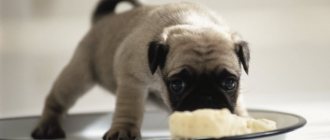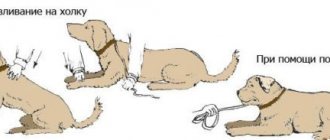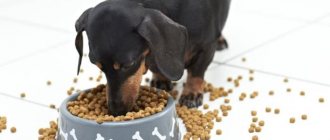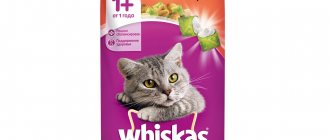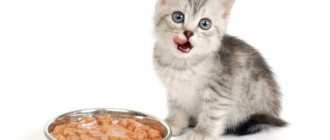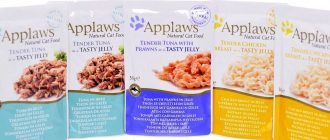Useful tips
In principle, there is no strict scheme for transferring from one type of food to another. Each pet must be approached individually. But there are several basic recommendations that will help us in this difficult matter:
- It is recommended to transfer to natural feeding within 10-14 days. This is a safer option that helps protect your pet from digestive disorders.
- Each new product should be introduced gradually (every 2-3 days). This is necessary so that in case of intolerance or allergy to any of the products, you can immediately identify it.
- It is better to start natural feeding with one type of protein (meat). Better with chicken or turkey. These types of meat are more dietary and are better absorbed by the four-legged body. Read all about the benefits and harms of chicken, and whether it is worth introducing this type of meat into the four-legged diet in the article: Is it possible to feed a dog chicken meat.
- After the body has already adapted to digesting poultry meat, you can introduce so-called “red meat” into the diet: beef, lamb, pork, and so on. Read about what kind of meat you should feed your dog.
- Natural food should be given separately from dry food - at different feedings. For example, in the morning - natural food, and in the evening - dry food (or vice versa).
- During the transition to natural food, be sure to monitor the general condition of the dog and digestive waste.
- Natural feeding is best done in the evening, as meat is digested slowly, resulting in a more restful and sound sleep for the dog.
- In the future, you will decide for yourself how to feed your pet: a natural raw diet or thermally processed food. But I recommend starting to switch your dog to natural food with thermally processed foods. Why? Yes, because this is a gentler option that reduces the risk of gastrointestinal disorders.
General principles and recommendations
Regardless of what your pet’s diet previously consisted of, if you decide to switch it to dry food, it is important for you to adhere to the following general rules and recommendations developed by specialists and veterinarians. These principles include the following points and will help accustom your dog to dry food with the least possible losses:
- The transition to dry food in dogs should be made gradually. Don't try to change your eating habits in one day. Nothing good will come of this. The animal's digestive system must be prepared for the new diet, and this must be done consistently. On average, if the dog’s body accepts the new food without problems, a complete transition to the new menu will take from 7 to 10 days. In the first few days, you will need to add dry food to your pet's main food in a ratio of 10-15% and 85-90% of the usual food. Then the proportions should be changed - they will be 25% to 75%. If there is no negative reaction from the body, after a few days you can reach a ratio of new and old food in the diet of 50% to 50%. After maintaining this proportion for several days, it will be possible to transfer the pet to a ratio of 75% to 25% and ultimately reach a 100% diet consisting of high-quality food.
- When an animal constantly eats the same type of food, a special microflora with its own specific bacteria exists in its gastrointestinal tract. Changing food not only becomes stressful for the pet’s body, but can also lead to dysbiosis, since existing specific bacteria may not be adapted to the new food. In order to populate the microflora useful for the new diet, it is recommended to give probiotics to the pet during the transition to a new food.
- If, during the process of transferring your dog to dry food, you notice that its coat condition has worsened, the animal has become lethargic and apathetic, suffers from an eating disorder or, on the contrary, constipation - most likely, the new food is not suitable for it. Look for an alternative to it. Often dogs have an individual intolerance to some components of the food - this is worth taking into account. In this case, there is no point in trying to “break” the animal’s body - this can have serious consequences. Just look for another food option.
- If you are planning to change the menu of your four-legged friend, choose high-quality types of food, be sure to take into account the recommendations regarding the breed, weight, and age of the pet. It’s also a good idea to take into account the dog’s health status. For example, if she has a sensitive digestive system, it will be more beneficial to feed her dry food, which includes the appropriate components.
Standard scheme for converting from dry food to natural food
So, let's look at the general scheme for transferring a dog to natural food. It is better to start with products such as: turkey (chicken, if you are not allergic), lean beef, rice. Gradually include vegetables in your diet: carrots, zucchini, pumpkin, fresh cucumbers, and so on. From 8-10 days you can already introduce fermented milk products, offal, fish.
With natural nutrition, the daily amount of food consumed by the pet should be 4-8% of the pet’s weight. The percentage depends on many factors: age, time of year and level of physical activity. For example, in puppies and active dogs the percentage will be higher. But older pets and animals leading a less active lifestyle need much less food, otherwise obesity may occur.
How to calculate a single serving? I suggest this option. For example, your pet weighs 10 kg. You yourself determine his level of physical activity and age. Let’s say your dog is of average activity and his age is also average. Therefore, the daily amount of food will be approximately 6%. That is, he should eat about 600 grams of food per day. Divide this by the number of feedings (let's say 2), and it turns out that a single serving for a pet will be about 300 grams. It's simple. But this is all approximate.
We should not forget that a dog is a predator by nature. Therefore, the main thing in a dog’s diet should be meat. If we take it as a percentage, then animal protein (meat, poultry, fish, eggs, cottage cheese, sour cream) should be about 60-70%, vegetables - 20-30% of the diet and only 10% should be cereals.
Many adherents of recently fashionable nutritional systems, such as, for example, the RAW nutritional system for dogs, categorically reject the inclusion of cereals in the four-legged diet. Their theory is based on the fact that in the wild the predator feeds only on the meat of the caught prey. This is true, but I can partially agree with this. The fact is that in the wild, the diet of wolves (which are considered the ancestors of dogs) consists of 70% field mice and small rodents. Big prey is a huge success for a predator. By eating whole mice, the wolf also eats the contents of their stomach, and these are grains and spikelets.
If we take the pet’s daily diet as 100%, then during the first 6 days, natural food should be no more than 30% of the total daily diet. Here is an approximate feeding schedule for your pet from days 1 to 6:
- Day 1: boiled turkey + grated and stewed zucchini + a little boiled rice.
- Day 2: boiled turkey + grated and stewed carrots and zucchini + a little boiled rice.
- Day 3: boiled turkey + grated and stewed pumpkin + a little boiled rice + lettuce.
- Day 4: boiled beef + grated and stewed carrots and zucchini + a little boiled rice.
- Day 5: boiled beef + any vegetables (zucchini or carrots, pumpkin or fresh cucumber) + a little boiled rice + lettuce.
- Day 6: boiled sea fish (pollock, cod) + any vegetables (zucchini or carrots, pumpkin or fresh cucumber) + a little boiled rice + lettuce.
To improve digestion, you can add a little vegetable oil to each meal.
Once again, if you want to switch your dog to natural food, then carefully monitor how your pet reacts to various foods.
If any of the products causes an allergy, then it should be immediately excluded from the four-legged diet.
From days 7 to 10, the amount of natural food should be increased to 50% of the total daily diet. In this case, you need to include fermented milk products (cottage cheese, yogurt, sour cream). But don’t overdo it, sometimes your dog can get diarrhea from an excess of fermented milk products. Here is an approximate feeding schedule for your pet from days 7 to 10:
- Day 7: boiled beef + any vegetables (zucchini or carrots, pumpkin or fresh cucumber) + a little boiled rice + lettuce.
- Day 8: morning: dry food, lunch: cottage cheese + a little sour cream + grated apple, dinner - boiled beef + any vegetables (zucchini or carrots, pumpkin or fresh cucumber) + a little boiled rice + lettuce.
- Day 9: morning: dry food, lunch: egg + stewed vegetables, dinner - boiled turkey + any vegetables (zucchini or carrots, pumpkin or fresh cucumber) + a little boiled rice + lettuce.
- Day 10: morning: dry food, dinner - boiled turkey + any vegetables (zucchini or carrots, pumpkin or fresh cucumber) + some boiled rice + lettuce.
Read about what foods can be given to four-legged animals and which ones are strictly forbidden. From days 11 to 14, the amount of natural food should already be 70% of the total daily ration, and dry food - 30%. If by this time the body of the tail has adapted to eating various muscle meats, it has formed stool, there are no gastrointestinal disorders, offal can be introduced into food. Read all about the benefits of offal and which offal should definitely be included in your dog's diet.
Approximate feeding schedule for your pet from days 11 to 14:
- Day 11: boiled beef + a little beef offal + any vegetables (zucchini or carrots, pumpkin or fresh cucumber) + a little boiled rice + lettuce.
- Day 12: boiled turkey (chicken) + a little chicken offal + any vegetables (zucchini or carrots, pumpkin or fresh cucumber) + a little boiled rice + lettuce.
- Day 13: boiled turkey (chicken) + a little chicken offal + any vegetables (zucchini or carrots, pumpkin or fresh cucumber) + a little boiled rice + lettuce.
- Day 14: boiled beef + a little beef offal + any vegetables (zucchini or carrots, pumpkin or fresh cucumber) + a little boiled rice + lettuce.
From day 15 you can already feed your dog completely with natural products.
If you feed your pet thermally processed foods (that is, boil meat), then we offer you EVEN MORE recipes. You can find them in the article: Natural food for dogs/20 recipes for every day.
Scheme for switching to a dry product
If your dog has previously eaten canned dog food, he will most likely not immediately like hard, dry kibble. But you should not mix wet and dry food.
It is better to choose dry food from the same manufacturer as the canned food you purchased. Then, if necessary, you can smoothly transfer to another brand.
This is the least stressful for the pet, however, here too we should not forget about the smooth transition. It is desirable that the new food be of the same class as was used previously. Mixing two types of product in one bowl is not recommended. It is better to separate feedings and monitor the reaction. In the case of an allergy or gastrointestinal disorder, the cause will be obvious. Previous recommendations will also remain relevant.
It is not difficult to correctly switch your dog to dry food.
| Day | Dry food | Natural food |
| 1-2 | 25% | 75% |
| 3-4 | 50% | 50% |
| 5-6 | 75% | 25% |
| 7-8 | 85% | 15% |
| 9th day and onwards | 100% | 0% |
After the final transition, the granules should be given in a soaked state for another month. At the beginning of the journey, it is allowed to treat your pet with natural products (meat, cheese), but no more than 10% of the total food volume.
- find out what the baby ate previously;
- switch to “drying” smoothly, slowly;
- grind granules to make it easier for the puppy to cope with new food;
- monitor for any reaction in the form of allergies or gastrointestinal disorders;
- encourage your pet.
You can switch your puppy to dry food no earlier than 4-5 months. By this age, a food interest is formed in his body and the enzymes that are needed to digest such foods mature. Manufacturers offer specially formulated foods for babies. You need to purchase premium quality food and higher.
The animal’s body has already formed enzymes that help digest “drying”. The pancreas will need time to adapt.
Most often, a dog breeder’s decision to switch to natural food is due to the following circumstances:
- the dog independently abandoned “drying” in favor of natural meat and other products;
- on the recommendation of a veterinarian in connection with the animal’s health condition;
- for the “ideological” reasons of a dog breeder who considers this type of nutrition more correct;
- It is not possible to regularly buy industrial feed.
The introduction of natural food occurs gradually - over 7-14 days. One way to switch to a new food is separate feeding. For example, in the morning give home-cooked food (porridge with meat, vegetables), and in the evening the usual food. This will make it easier to monitor the body’s reaction.
You can start with foods such as beef, sea fish (not fatty), buckwheat, rice, carrots, sunflower oil, fresh cottage cheese.
Day 1: buckwheat porridge with beef or chicken.
Day 2: rice porridge with beef or chicken.
Day 3: oatmeal porridge with beef or chicken.
Day 4: buckwheat porridge with sea fish.
We suggest you familiarize yourself with: Tripelphosphates in urine: struvite and renal salts
Day 5: rice porridge with sea fish.
Day 6: oatmeal porridge with sea fish.
From the 7th day - a gradual increase in natural products and a decrease in the amount of dry food. Vegetables and dairy products are introduced. The transition to a new food is completed on the 14th day. To facilitate adaptation, you can gradually soak the dry granules with water or broth.
It is very important to create a well-balanced diet for your dog so that it meets all the needs of its body. Therefore, to switch your dog from dry food to natural food, consider the advice of your veterinarian. One of them is to regularly conduct vitamin courses.
If you experience negative reactions to a new food, you should contact your veterinarian. Perhaps they are associated with some disease.
If your pet is still a puppy, you need to switch to a new type of food even more carefully and carefully. It is not advisable for this process to take place during the vaccination period. From the point of view of a puppy's habit, it is easier to switch to a new type of food than an adult dog.
Natural food, unlike factory feed, contains all the substances necessary for the animal in their natural form. Many breeders want to protect their pet from attractive taste and smell enhancers, dangerous additives and lack of vitamins.
Natural food, first of all, will be more enjoyable for the dog itself. Dry granules that are too hard can cause damage to fragile teeth and delicate oral tissues.
In addition, it is quite difficult for inexperienced breeders to distinguish suitable factory food from one that can harm the health of the pet. Cheap food contains almost no meat and no substances that the dog’s body requires.
The main reasons when there is a need to switch to another dry food are most often:
- suspicions of allergies, as evidenced by constant scratching and skin problems;
- excess or underweight (subject to optimal portion sizes and normal physical activity);
- loss of shine of the coat, its slight loss;
- lethargy, lack of interest in games, long walks;
- diarrhea and vomiting, constantly or at regular intervals, occurring shortly after feeding;
- features of physiology: age, illness.
If you doubt your knowledge of nutrition, then contact your veterinarian to create a menu.
If you are thinking about how to properly create a nutrition plan when switching your dog to dry food, it is best to do this as directed and under the supervision of a veterinarian. The doctor will be able to identify the reasons for the pet’s problems. He will recommend the most optimal type of food, which, depending on the pet’s condition and its problem, can be natural, canned or dry.
Switching to dry food does not entail a complete abandonment of other products
When deciding to change your diet, you need to adhere to the following rules:
- gradualism, which should last from one to two weeks;
- persistence if the animal categorically refuses unfamiliar food;
- The most important thing in how to accustom your pet to dry food is to make the right choice of a new product: this can be provided by a recommendation from a veterinarian or by independent painstaking study of all the features of different brands of dry food and canned food, calculating the nutritional value and vitamin-mineral composition of a natural diet.
Changing food requires gradual adaptation and should not be done at once.
The most common situation is transferring an animal from one dry food to another. It is advisable to “stretch” this process for at least a week. The table below shows a diet change scheme that is quite easy for the owner and gentle for the four-legged friend.
Table 1. Dog feeding plan when changing food
| Period/days | Old food | New food |
| 1st and 2nd | 75% | 25% |
| 3rd and 4th | 50% | 50% |
| 5th and 6th | 25% | 75% |
| 7th and subsequent | 0% | 100% |
Having measured out the daily amount of old and new “drying”, it must be mixed well and divided into two parts - for morning and evening feeding. This must be done every day. And starting from the 7th, you can safely switch to a new brand.
Only after a week will the dog be ready to finally give up the old diet
- will the budget support the regular purchase of industrial food or can you save money by daily offering your dog food cooked from inexpensive offal and trimmings;
- do owners have enough time to regularly purchase food and then prepare dog soup or porridge;
- how the dog’s body reacts to different types of food: if something is categorically unsuitable, causing negative reactions, this food will have to be abandoned.
The optimal feeding scheme for a pet depends on its health and the wealth of its owner.
By the way, these same criteria should be used when thinking about how to choose food for a dog when the puppy turns into an adult and its diet must undergo changes in both volume and quality.
Each type of nutrition has its pros and cons.
Dry food
Very convenient to use. It contains the entire necessary set of nutrients, vitamins and microelements. You can choose a brand intended for healthy dogs of different breeds and ages. There are special brands of products for pets with health problems.
When choosing dry food, it is not recommended to settle on budget options
It has a long shelf life, allowing you to keep it at room temperature without worrying about special containers - “drying” retains its properties well even in an unpacked paper bag. Thanks to this, you can purchase in large quantities or bags.
This is a waste-free product - if there is uneaten food left in the bowl, it will not spoil and can be safely given at the next meal. Among the disadvantages is the price. The better the food, the higher its cost. Premium class products are not available to every dog owner. If you are introducing your pet to dry food for the first time, then on our portal you can find recommendations and tips on this topic.
Premium food is able to provide the pet’s body with a set of all necessary substances
Sold in portioned bags or in jars. Good for feeding four-legged dwarf breeds, when the dog can easily handle a miniature jar or the contents of the bag in one sitting. This is a well-balanced product that takes into account the needs of the breed.
This type of food is not very convenient for feeding dogs of medium and large breeds: large cans weigh quite a lot. When purchasing a large batch, you will have to resolve the issue of transportation.
The main disadvantage of canned food is its strong specific smell.
Puppies will be able to chew dry food only when they have all their molars.
Switching to natural food requires a lot of effort on the part of the pet’s gastrointestinal tract
Exceptional cases
Sometimes, after trying natural food, the furry prankster categorically refuses to eat dry food. In such cases (if the pet is completely healthy, of course), you can switch the dog to natural food in 3-4 days.
Well, in some cases, the transfer is carried out by adding a small amount of natural products to dry food (this is when both dry and natural food are given at one feeding). In this case, the ratio should be like this:
- Days 1-3 – 75% dry and 25% natural food.
- Days 4-6 – 50% dry and 50% natural food.
- Days 7-10 – 25% dry and 75% natural food.
- Days 10-14 – 0% dry and 100% natural food.
There is an opinion that dry and natural food should never be mixed. But again, everything is individual. Carefully monitor your pet during the transition from one food to another, and then everything will be fine.
There are other ways to transfer a four-legged animal to natural nutrition. You can read more about each of them and other recommendations in the material: How to switch a dog to natural raw food.
Reasons for changing feed
Owners rarely decide to switch their dog from dry food to natural food. After all, feeding with industrial canned food and granules is convenient and safe.
The main reason for the transition is the deterioration of the pet’s health, namely:
- dulling of fur;
- apathy, lethargy;
- overweight or underweight;
- eating disorders;
- refusal of industrial feed.
If such symptoms appear, you should take your pet to the veterinarian. If the examination does not show the presence of diseases, you can begin the transition to “natural food”.
What you definitely need to know
If you have decided to switch your dog to natural feeding, then the following information will be useful to you:
- With natural food, more moisture enters the pet’s body, and it needs to drink less. Therefore, there is no need to worry if your four-legged dog begins to drink less. But this does not mean that the water needs to be removed altogether. There should be water in the bowl at all times, regardless of whether your furry friend eats natural or dry food. Introduce new foods into the diet gradually, studying the reaction of your pet’s body.
- If before you still pampered your sand with natural products, then the transition will take less time than if the tailed one ate exclusively dry food.
- The transfer may be accompanied by diarrhea, partial indigestion of certain foods, therefore, during the transfer from one food to another, be sure to give the dog probiotics (food products and dietary supplements containing live microcultures) that help improve digestion.
- Since natural food contains more moisture, your pet may need to go to the toilet more often. Therefore, do not scold him, but be patient until everything returns to normal and the functioning of the gastrointestinal tract returns to normal.
- Well, if, when switching to natural food, the dog refuses to eat at all, has constant diarrhea and vomiting, then you definitely need to contact a veterinarian to identify the reasons why switching to natural feeding is difficult.
Well, in general, this whole process occurs individually for each animal. Monitor your pet carefully during this time. And when your dog finally starts eating natural food, you will see for yourself how he will immediately become happy and cheerful.
Typical translation cases
Depending on the dog’s previous diet, it is worth considering some features on how to properly accustom it to dry food. And now we will tell you about them.
Translation from natural nutrition
If you previously fed your pet natural food - porridge with meat, vegetables, and now you decide to change the menu - follow several rules for transferring your dog from natural food to dry food:
- On the first day, it will be enough to let your pet smell a little food, and if he shows interest in it, give him a treat.
- You should not mix dry food with porridge - although this will make it easier to switch the dog to a new menu. This mixture of porridge and dry food is a serious burden for the digestive tract.
- Try to allow at least several hours between feeding dry and natural food.
- Make sure that your pet always has access to clean and fresh water in unlimited quantities, as he will drink more when he starts eating dry food.
Transfer from wet food
If your dog previously ate only wet food - in the form of canned food or packaged in pouches, then you need to switch it to dry food in general in the same way as in the case of switching to natural food. Here are a few recommendations from our side:
- To avoid gastrointestinal disorders or allergies, try to choose food within the brand that you have already used.
- Follow standard guidelines for gradually introducing dry food in proportion to wet food.
- You should also not mix wet food with dry food in one feeding. If at first it is difficult for your pet to get used to dry food, it can be pre-soaked in water, filled with broth or fermented milk products so that its consistency is softer and more familiar to the dog.
Don't forget about access to clean and fresh water.
Transfer to another dry food
Now let's move on to the case in which it became necessary to replace one type of dry food with another in the dog's diet. Here it is also necessary to take into account all the recommendations in the first block of our article. In addition, there are several recommendations that it is advisable to follow in order to minimize all possible problems for the animal from such a change.
- It is highly advisable to maintain the class of food you fed your pet. If the previous food was super-premium, then the next one should be of at least a lower class.
- Also avoid mixing different types of dry food in your dog's bowl. Separate the feeding and observe the animal's reaction. After all, if something unpredictable happens, for example, a disorder, it will be difficult to determine the true cause. And experimenting with a dog’s health is not the best method of switching to a new dry food.
Transferring an adult dog to dry food
Changing the diet in youth and adolescence is much easier for an animal than in adulthood. And you must be prepared for this. Switching an adult dog to dry food is a slightly more complex and time-consuming process, but still doable. So, be patient and prepare for the fact that you will have to try several types of food before you get your adult pet used to a new one. Be sure to choose food of good quality and according to the age category, follow all the rules indicated above and you will succeed.
Dry food is healthy and not so good
Although dry food has been on the menu for dogs all over the world for almost 160 years (since 1860), there are owners who do not trust ready-made industrial products. The Internet is full of angry reviews about purchased “dry food” (like “dry food killed my dog”, etc.). Indeed, industrial feed can be harmful, but only if it is an economy-class product. It contains the following unhealthy components: soybeans, cheap and not very necessary grains for dogs (like corn), by-products of dubious quality (extract from meat waste from sick or even dead animals). The most annoying thing is that economy class food is the most advertised. Their manufacturers promise dogs health and longevity, although in reality such “drying” is actually poison for pets, seasoned with flavorings and taste enhancers.
The situation is completely different with high-quality feed. For example, in popular holistic formulas (“Akana”, “Grandorf”, “Savarra”, etc.), the first place in the composition is occupied by fresh and dehydrated meat, eggs, vegetables, cereals, poultry fat, amino acids, antioxidants and lactobacilli, microelements. Of course, such dry food will not harm the dog, but will bring satiation and benefit. True, these products have several relative disadvantages: they are not on the shelves of large stores, they are not always found in pet stores, and the cost of quality food is always high. In addition, pets, accustomed from childhood to cheap food, which contains many harmful additives, sometimes refuse to eat holistic and premium food for a long time (probably, they simply seem tasteless to dogs, because there are no fragrances or flavor enhancers in the composition).
